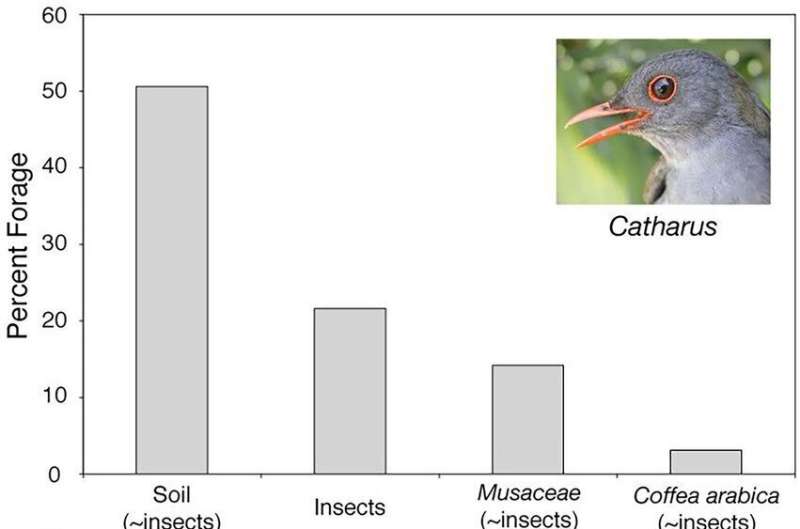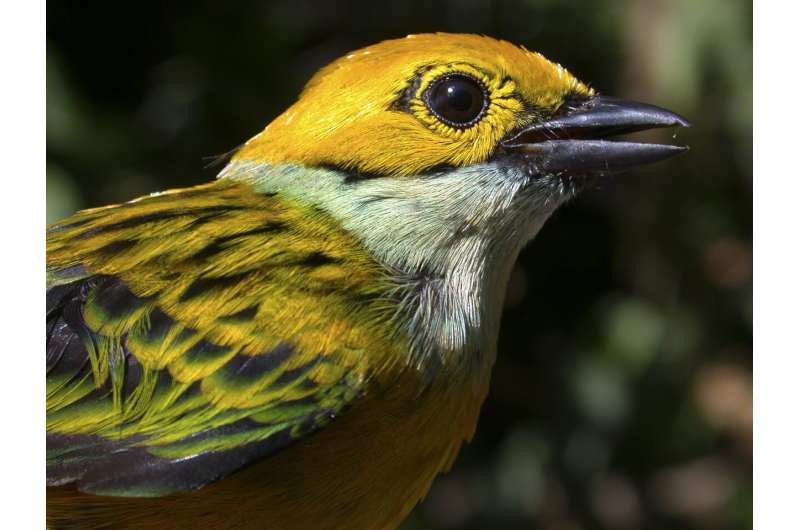How coffee plantations limit birds’ diets

Cast your mind back to the spring of 2020, when grocery store shelves sat bare of essential items and ingredients. For birds who live in the forests of Central America, replacement of forest land with coffee plantations essentially “clears out the shelves” of their preferred foods, causing them to shift their diets and habitats to survive.
A new study led by researchers at the University of Utah explores a record of birds’ diets preserved in their feathers and radio tracking of their movements to find that birds eat far fewer invertebrates in coffee plantations than in forests, suggesting that the disturbance of their ecosystem significantly impacts the birds’ dietary options.
“Growing human ecological impact on the planet, especially via habitat loss and degradation and climate change, often impacts bird diets negatively as well,” said Çağan H. Şekercioğlu, the study’s lead author and an ecology and ornithology professor in the U’s School of Biological Sciences. “These negative changes, including declines in key dietary resources like insects and other invertebrates can lead to reduced survival, especially of rapidly growing young, often leading to population declines and losses of these undernourished birds.”
The study is published in Frontiers of Ecology and Evolution.
The forests of Costa Rica
All over the world, forests are being reduced from once-verdant havens of life to much smaller remnants, scattered amongst the agricultural land that has replaced them. Only about one percent of bird species prefer the types of habitats dominated by humans and human activity, but the rapid disappearance of natural forest habitat means that about a third of bird species now find themselves working to survive in human-dominated environments.
In Costa Rica, the land around the Las Cruces Biological Station near the Panama border, has gone from fully forested to now 50% coffee plantations, 20% cattle pastures and 10% other human environments—only 20% of the land is still forested. The agricultural areas are drenched in pesticides, fertilizers and fungicides, drastically impacting the communities of invertebrates on which local birds feed.
Those local birds include four species that the researchers focused on in the study: orange-billed nightingale-thrush, silver-throated tanager, white-throated thrush and ochre-bellied flycatcher. All four species can be found in both the forests and the open countryside where they feed on both fruits and invertebrates. But the invertebrates (including insects) are an important part of their diet, since they provide key nutrients including protein and nitrogen.
Şekercioğlu and his colleagues, including researchers from the United States, Costa Rica, and Singapore, wanted to understand how the bird species they studied were obtaining their nutrients between the agricultural and forest environments, specifically during the crucial breeding season when proper nutrition is key to sustaining the species.
An isotopic food diary
To learn more about the birds’ diet, the researchers analyzed isotopes in their feathers. We are what we eat, and the chemical signatures of the foods we eat, in the form of isotope ratios, are incorporated into our tissues.
Isotopes are different versions of the same element that differ only in the amount of neutrons in their nucleus—an infinitesimal difference in mass between a carbon atom with, say, six neutrons and a carbon atom with seven. But biological and physical processes can prefer either light or heavy isotopes, changing the resulting ratio in a way that can be measured and can provide valuable information.
In humans, for example, a record of our diets is preserved in the isotopes in our hair. In a previous study, co-author Thure Cerling, a distinguished professor in the University of Utah’s Department of Geology and Geophysics, and colleagues analyzed hair clippings from barbershops and salons around the Salt Lake Valley and learned about the relative ratios of corn-fed meat and plant-based protein in the diets of local residents.
In Costa Rica, the researchers hoped to do the same, but with the stable carbon and nitrogen isotopes in the birds’ feathers. They collected 170 feathers from the four bird species to analyze diet, and tracked 49 birds’ movements using radio tracking to see where they spent their time.

“It’s definitely not the first time feather isotopic analysis has been used to study bird diets,” said co-author Seth Newsome of the University of New Mexico, “but it might be the first time, especially in the tropics, it has been used in conjunction with radio telemetry to examine diet composition and relative use of agricultural versus natural habitats.”
The results showed that the birds’ habitat of choice had a significant effect on their diet. The isotopic data suggested that three of the four species studied ate significantly fewer invertebrates in coffee plantations than in forests. For silver-throated tanagers and the white-throated thrushes, the data suggested that they were eating twice as much invertebrate biomass in forests than in coffee plantations.
“Our results suggest that coffee plantations are deficient in invertebrates preferred by forest generalist birds that forage in both native forest remnants and coffee plantations,” Şekercioğlu said.
Consequences of habitat shifts
The coffee plantations were planted decades ago, and the researchers don’t have the data to know how the birds behaved when the forest was intact. But from what we know about the birds’ behaviors now, we can infer what the results mean for the birds’ lifestyles.
To consume enough invertebrates, Şekercioğlu said, the birds need to forage frequently in the small forest fragments of around 7-12 acres (about the size of the parking lot at the U’s Rice-Eccles Stadium) and narrow corridors of forests alongside rivers, only around 30-60 ft wide.
“We think that the more mobile birds like silver-throated tanager and white-throated thrush move constantly to get enough food, especially protein-rich invertebrates,” Şekercioğlu said, a hypothesis supported by a 2007 radio tracking study. “Less mobile species like orange-billed nightingale thrush that can have lifelong home range sizes as small as an acre (half a hectare) either have to adapt to coffee plantations and eat fewer invertebrates or they disappear.”
The orange-billed nightingale thrush isn’t alone—a 2019 study showed that more bird species were in decline in the region than were stable.
So for the birds of Costa Rica, and for birds in other, similar tropical regions, forest reserves can provide critical resources for birds that have shifted their habitats to the remaining forest and travel through coffee plantations to reach other forest fragments.
“These birds’ shifting their feeding to other places may result in new ecological interactions that can themselves have negative consequences,” Şekercioğlu said. “For example, increased competition with birds in these new places or overpredation on a prey species that was formerly not consumed as much.”
How you can help
If you’re a coffee drinker, you can help by choosing to buy bird-friendly coffee. According to Şekercioğlu, bird-friendly coffee is grown in plantations with more tree cover and forest remnants, which are beneficial for native birds. He recommends buying shade-grown coffee, coffee certified as Bird Friendly by the Smithsonian Migratory Bird Center, or coffee from Ethiopia which, he said, is among the bird-friendliest.
And local governments in tropical regions can help by prioritizing the conservation of intact forest, secondary growth forests and strips of forest alongside rivers to increase the connectivity of forest remnants.
“It is urgent,” Şekercioğlu said, “to prioritize the conservation and regeneration of forest remnants in increasingly human-dominated agricultural areas that continue to replace the world’s most biodiverse tropical forests.”
More information:
Çağan H. Şekercioğlu et al, Using stable isotopes to measure the dietary responses of Costa Rican forest birds to agricultural countryside, Frontiers in Ecology and Evolution (2023). DOI: 10.3389/fevo.2023.1086616
Citation:
How coffee plantations limit birds’ diets (2023, March 17)
retrieved 17 March 2023
from https://phys.org/news/2023-03-coffee-plantations-limit-birds-diets.html
This document is subject to copyright. Apart from any fair dealing for the purpose of private study or research, no
part may be reproduced without the written permission. The content is provided for information purposes only.
For all the latest Science News Click Here
For the latest news and updates, follow us on Google News.

